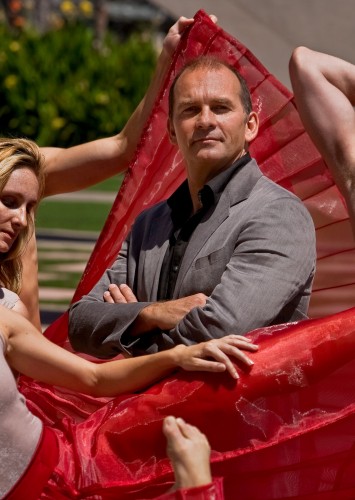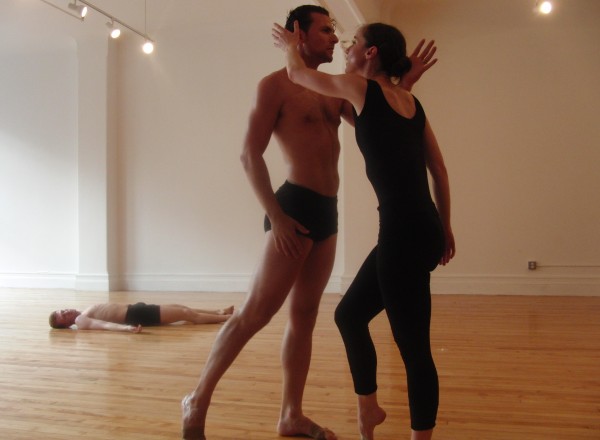
The always elegant Pascal Rioult will present two new works and repertory favorites at the Joyce this week
The Joyce Theater
175 Eighth Ave. at 19th St.
June 14-19, $10-$49
212-691-9740
www.joyce.org
www.rioult.org
New York City–based French choreographer Pascal Rioult, who established himself as a performer dancing with May O’Donnell, Paul Sanasardo, and, most famously, Martha Graham in the late 1980s and early 1990s, formed his own company in 1994 and has been challenging the precepts of contemporary dance ever since. Favoring sensual movement set to classical music, Rioult has put together such thematic evenings as “The Ravel Project,” “The Stravinsky Program,” and “Bare Bach” that combine new works with reimagined and reinterpreted classics. For his upcoming season at the Joyce, running June 14-19, he will be presenting two programs: one consisting of the all-Bach Views of the Fleeting World (“The Art of Fugue”), City (“Sonata for Violin and Harpsichord #6 in G major”), and the world premiere of Celestial Tides (the Brandenburg Concerti), the second, performed to live music, featuring Black Diamond (Stravinsky), Bolero (Ravel), and the new On Distant Shores, a beautiful dance about Helen of Troy (a sparkling Charis Haines) with a commissioned score by Pulitzer Prize–winning composer Aaron J Kernis. After watching a sweaty rehearsal of On Distant Shores and Celestial Tides on an impossibly hot day, twi-ny met with the former track and field athlete, who graciously agreed to participate in a twi-ny talk as he prepared for his latest New York season.
twi-ny: You’ve devoted previous evenings to Ravel, Stravinsky, and Mozart, and you will be presenting a night of Bach at the Joyce. What are some of the specific challenges, as well as joys, in interpreting Bach onstage?
Pascal Rioult: I have always loved Bach’s music, instinctively and without understanding where the magic came from. It is specifically because of my intense work with the music of two great composition masters, Ravel and Stravinsky, in the past eight years that I felt it was time to “go to the source” of contrapuntal music and try to understand the great mystery of “Harmony.” (“Mysterium Harmonicum” was at the time of Bach an art and philosophy theory believing that there was some sort of mysterious forces that kept the Universe in balance and created a “Music of the Spheres” — a Divine Harmony.)
I love this concept in Art as in Life (I called the closing piece of the Bach program Celestial Tides). Certainly Bach’s mastery of counterpoint must come very close to this Divine Harmony.
But I also want with my dances to show that Bach’s music, contrary to common belief, is unbelievably rich emotionally.
twi-ny: Which composer might you have your sights set on next?
PR: I am not sure yet about which composer will be next, although I love Russian music and have not used it yet.
twi-ny: You also have the new series “Dance to Contemporary Composers,” which includes a newly adapted composition by Aaron J Kernis that will be performed live at the Joyce. How did that collaboration come about?
PR: It is time for me to work with contemporary composers (living composers). On the other hand, I suffer from not being able to have live music for my performances, which makes such a difference. So I decided to try to get support for the project of commissioning new music and have it played live for the next three years.
I have known and admired Aaron J Kernis’s music for many years, and we had wanted to collaborate for a while but did not get the opportunity yet. His music fits my concerns about the classical form as well as being filled with emotional content. I discussed with him my idea about a piece based on the character of Helen of Troy that I described as a “redemption fantasy.” We had to portray in a few minutes the epic of the Trojan war for the male heroes, then slip into the dream world created by Helen’s imagination and finish with a way to redemption. I knew it would be very rewarding to work with Aaron, and it has been a great collaborative experience resulting in a brilliant piece of music.

Michael Spencer Phillips and Charis Haines get hot and heavy rehearsing ON DISTANT SHORES in preparation for world premiere at the Joyce (photo by twi-ny/mdr)
twi-ny: What is it about Helen that drew you to her?
PR: I have always thought that Helen of Troy got a wrongful reputation. She would have been the cause of one of the most horrible wars that ever was, because she left her husband for another man. Was it not as usual the men’s unrelenting need of violence and conquest that drove them to Troy and made Helen a convenient pretext?
I found in the Euripides play Helen a similar version of the fact/myth. The mischievous gods had made a likeness of Helen from the clouds and that is the mirage that Paris took away to Troy, and it is for that “mirage” that so many lives were lost.
It was time for me to redeem Helen.
twi-ny: In addition to the obvious physical contact, your dancers make extraordinary, very emotional eye contact with one another while performing. Is that something you teach them? How important is that when you are choreographing a piece?
PR: As a matter of fact, I never give the dancers direction about expressions. On the contrary, I usually keep them from using facial expressions at all. Dancers do not need it because the expression comes forth through the body itself, from the inner core (you could say the inner self). Then the energy that creates the appropriate expression radiates towards the outside (including, at last, the face). You see, that is what we call “radiance,” “projection.” . . . You cannot help it if it comes from the right place. You don’t need to “put it on” and I don’t need to teach it.
I learned that from my mentor, Martha Graham.